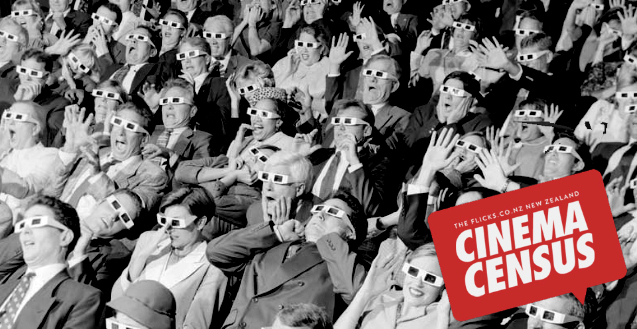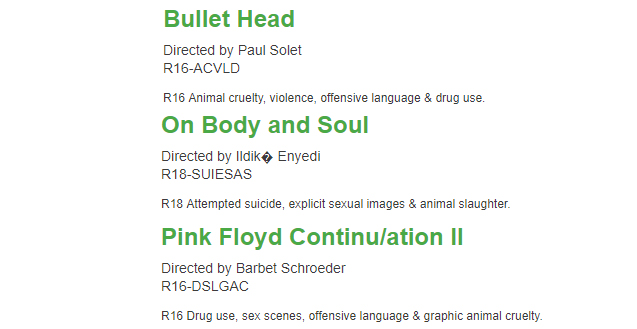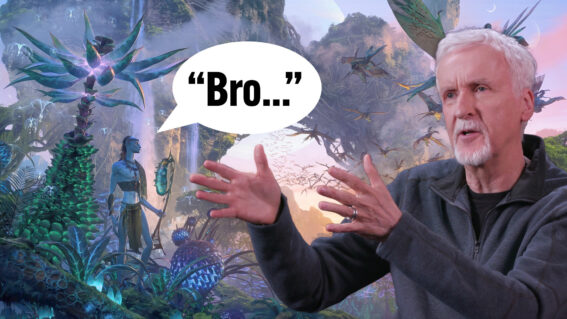We chat with the Chief Censor about Kiwis’ thoughts on film classifications
David Shanks responds to what you told us about classifications

The recent Flicks Cinema Census surveyed the behaviours and attitudes of moviegoers around Aotearoa and to date we’ve reported on how we’ve changed the way we watch movies, the massive impact of streaming, and the appalling etiquette of our fellow cinema patrons.
Among the exhaustive list of questions asked: “Do you take into consideration age classifications and notes about content? (For example: M suicide, sex scenes, offensive language and drug use).”
The responses, collected from nearly 5000 Kiwis, show that less than one-third of moviegoers check the classification of films. We’ve published a selection of Cinema Census responses that provide further insight into the reasoning behind this behaviour.
Chief Censor David Shanks spoke with us about these results in a conversation that sheds light on the classification system and allowed Shanks to respond to some of the feedback gathered by Flicks.
FLICKS: How are films classified?
DAVID SHANKS: We run according to a statutory regime in terms of the Films, Videos, and Publications Classification Act. And according to that regime, we have systematised the classification process into classifiable content scoring sheets that we work through when we watch a film.
We will watch a major release at one of the local cinemas, and for a big release, we would have a classification officer who’s going to write it up, a senior, and possibly also myself or my deputy chief censor. And essentially, the classification advisor who’s responsible for the classification will go through it and find classifiable elements, capturing that, producing a note that you might have seen, that quite comprehensive classification write up [like this one].
And then we have a discussion pretty much straight away after we’ve viewed the film, about, “Okay. What’s in it? What are the classifiable elements? What’s the likely age rating or restriction if there’s going to be one? And if so, what are the key elements that should be put in the note?” And if possible, we will use the note that we have used before. So we’ve got combinations like “Contains violence, offensive language, and drug use”. That’s quite a common one for an R16 rating. And if we’re looking at a film and those are the key elements that present as needing notification, that’s what we use.
How do you take into account changing societal attitudes and the rapid evolution of views about particular types of content?
Well, I think what we’ve got to do is keep dialed into those shifts in the public and in particular, the views of youth. I think that’s the only possible way to keep pace because the landscape is changing rapidly, as is demonstrated by the Cinema Census and plenty of other indicators. The industry is shifting rapidly. Content is shifting rapidly. Attitudes are shifting. And we’ll be in an increasingly irrelevant space if we don’t kind of at least attempt to keep pace with those changes and use whatever feedback mechanisms we can.
One of the things that we did recently involved me calling in Once Upon a Deadpool, which is a very interesting film from a classification point of view because that is a film that is essentially a re-edited version of Deadpool 2, specifically for purpose of achieving a PG-13 rating under the MPAA classification, right? That’s what it is, and I can see exactly what they’ve done to just get that objectionable content within that classification according to the MPAA in the US. [Check out an interesting story on Stuff, published at the time of the reclassification]
Now in the UK, the UK rated Deadpool 2 as a 15, so that’s, I think, equivalent to our R16 under the UK system. And they had a look at Once Upon a Deadpool and they gave it the same classification because they’re not navigating to the same kind of cues, the same sensitivities of language, nudity, the kinds of things that the MPAA system will respond to, right? And so we had a look at Once Upon a Deadpool and we went, look, it has been toned down. It isn’t as impactful and potentially problematic for teenagers as Deadpool 2 is, but it’s not there according to the rules and legislation that we operate to. So that is an R13 in this jurisdiction.
And the other interesting thing about that is that neither the UK nor Australia has an equivalent to our R13 which I’m increasingly seeing as potentially quite a useful classification. But looping out of all of that, back to your original question about how do you keep pace. When we had a look at Once Upon a Deadpool we took along some of our youth advisory panel users.
We’ve got a youth advisory panel called YAP, 12 young people aged between 16 and 20 that we have been meeting with, working with and getting all sorts of engagement and insights into a number of areas that we work in. And we took the opportunity to take three of them along to the screening and gauge their reactions, their feelings and a comparison to Deadpool 2 in terms of content so to triangulate the result that we got to.
I came back here and I said to the classifications team here, “This film is an absolute classic reference point for us in terms of triangulating on international approaches and attitudes”. Because it’s just so finely tuned to achieve that specific classification and I can see exactly what they’ve done. Didn’t work in the UK, worked in Australia and Australia gave an M classification and for here it worked to an extent but not all the way. And that sort of comparisons you’ve got in the snapshot, some of the differences that are operating right now.
How did you feel about the Census statistic that only 32% the respondents pay attention to classifications at all?
Look, it didn’t entirely surprise me and to some extent, it correlated with some of the other surveys and checks that we’ve undertaken in the past. If you had surveyed me in my twenties or thirties, I quite easily could have seen myself responding to that question in a similar sort of vein: “I’m not particularly concerned about any specific aspect of content. I don’t have kids and I’m not a kid myself, so fine”. So that’s okay. That’s absolutely fine.
It’s increasingly obvious that the real area to focus on is with young people themselves. That’s why we’re talking to young people. It’s parents and guardians and people that are making choices for young people and then it’s quite a big group in between who go, “Look, I don’t care about most stuff but if there’s animal cruelty in there, I won’t see it. I just don’t want to expose myself to that or I’ve got a particular concern about self-harm or suicide,” or whatever.
There’s a really high incidence of people referencing the concept of triggering in Cinema Census responses, both for themselves personally and also for others. That’s really strongly represented in the younger age group. How does that tie in with what you’re observing at your end?
It ties in absolutely with a one-to-one correspondence with what we’re seeing at this end. I mean, triggering as a concept is something that young people use a lot. They’re familiar with the concept and in a way where maybe I’m even trying come up to speed with exactly what it is and how it applies. But young people are very on to it with that as a concept and use it frequently in terms of describing their response or the impact on others, right? And it’s gaining kind of increased traction as an idea around what can happen.
I tried to avoid that phrase when I was doing some media comments around A Star is Born issues because I think it can be loaded with kind of clinical import or other connotations that may be apparent there. But at the end of the day, what we had with A Star is Born was a report of a pretty serious reaction by some vulnerable younger people who had gone to the movie and didn’t expect that content. And our discussions with Mental Health Foundation immediately on hearing that concern to us that this wasn’t just an isolated incident. It actually was an issue, so we needed to do what we could in response to that. So we’ve had quite a strong resonance, I think, across the board with young public and commentators going, “Well, that’s probably reasonable.”
We didn’t even increase the classification in that case. It came across cross-rated at from Australia, and when we classified it, we felt that was probably about right for New Zealand audiences, but it just needed some fair warning for people that might be vulnerable to that sort of content.
Look, I was struck by the scene that’s relevant to this, and I’ve got no personal experience with that issue. But I was watching it, and I was taken aback thinking there’s going to be a large volume of people who have literally been in the same position as the camera in this scene.
This is purely a personal impact, and I’ve spent significant time with senior people at Ministry of Health and elsewhere who deal with this stuff every day who will not go see a film like this for obvious reasons, who tell me that hanging is by far and away the most common method of suicide in this country.
And so, you’re exactly right. You line up all of those factors and you watch A Star is Born—which is an awesome movie, by the way, I watched it with my wife and thought it was incredible, Lady Gaga just blows the roof off in that film. The presentation is not problematic, it’s not instructional, it’s not promotional or glorified in the ways that some of those problematic films and series have dealt with it. So it didn’t have those kind of aggravating factors. But you can’t get away from the fact that it was the emotional fulcrum of the whole film. The whole film pivoted on that act and that scene, right? So that really kind of maximises the impact.
Are we one of the only countries that warns about suicide content?
It’s emerging that if we’re not the only one, we’re one of a small group. And another interesting element around this is we ran some numbers on them when we first started, including warnings about suicide classification rates. I think from memory the first film was back in 2004. There’s a film called The Bridge, which was quite graphic in terms of its treatment of suicide. We’ve got an overview of how often we’d use that warning. Immediately post-2004 you might see it two or three times a year. There might be a year that we didn’t use it at all. And then probably over the past 10 years or so it’s just ramped up and up and up and I think it was 26, 28 times last year.
It was just striking how that’s progressed, and I think there are two factors there. One is, we are kind of more alert to what’s triggering. We have the responsibility to warn of that sort of content but the thing is, I think there’s just more of that content coming through.
Do you think that the way that things are going with the increase in awareness around triggering with individuals, that we are going to see more detailed notes being provided in the future around about film content?
Well, look, in the future depending on your time-frame reference we’ll probably have AI devices that kind of warn us specifically in a personalised way about exactly what it is, and what we might want to avoid, and what we might want to watch. That’s down the track. In the process of getting to that kind of future, it’s a balance, right? Because what we are essentially about is providing age restrictions where we have to, but more importantly, given that all of these films and products are going to be available online and we know kids are going to access them anyway, getting the right sorts of consumer information packaged up with those products.
There is always a fine line around consumer information between detail and personalisation, having that accessible and easily digestible at a glance. So I think we are always going to get that tension between going “it would be really good to provide this descriptor of this kind of risk, but actually we’re creating a note that people are just going to glaze over or not read”. I think there’s always going to be a bit of a dynamic tension about that.
Let’s move on to the criticism about that spoiling the film for people because, from my point of view, I thought the subsequent discussion itself about the note was actually what was spoiling the film.
Look, my take on that is I think you captured it in a nutshell. The discussion is the spoiler. A note that says suicide or suicide themes or something, to my mind, almost by definition, cannot be a spoiler because this could be a suicide of a minor character incidental to the plot, but it’s in there and it’s problematic. So they’re not saying anything about where it is, who it is, how it works. They’re saying it is in there. So comments about it being a spoiler, from my mind, are pretty tangential.
Setting apart that film in particular for a minute, there were some responses that sort of alluded to that just in general terms, like classifications give too much away. But then the other side of that are responses saying people use them to help choose their film. As in, “I want to see a horror but I don’t want to watch PG-rated horror.” Is it amusing to contemplate people using classification guides for perhaps the opposite purpose of how they may be intended?
Oh, no. It’s known, right? I was just talking with one of my staff here, about exactly that. Thinking about some of my movie selection behaviours in my twenties and, yeah, I totally get that. If you’re in the mood for a high impact really scary horror that’s going to have you on the edge of your seat and get your eyes out on stalks, you’re not going to want a PG.
You just go, “Right, okay, that’s where I want to go.” It doesn’t surprise me and it doesn’t particularly bother me someone’s going, “Yeah, I’m in the mood for that. That’s what I want. I’m looking for that.” It’s completely fine. It’s just another piece of consumer information that people can use to guide your choices.
There were some, not a huge amount, of responses critical of censorship and classifications in general. I think you can expect probably some of those comments from people sitting behind their computers anonymously completing their survey. But I just wanted to check a couple things with you. Do you wear cardigans? Because one response says of classifications “Why would I consider it. I can make my own decisions, not some stuffy cardigan wearing censor.”
Well, I’m looking around the office right now, and I can’t see anyone wearing a cardigan. I can see someone wearing an elf outfit, which is a bit perturbing—a Christmas elf outfit, but no we don’t wear cardigans.
I just wanted to confirm that, thank you.
We tend to have a smart casual kind of office clothing policy, but obviously, if you wanted to wear a cardigan there would be nothing stopping you from doing that! People choose not to in my experience.
But look, on that more broadly, I totally get that that there is always going to be a view that says, “Look, actually my rights are my rights and I’m going to push back against anyone that says otherwise and censorship is quite an ugly word and I’m against it. I’m against any kind of restriction, and I’m in favour of freedom of speech.” I totally get that point of view, and it’s legitimate in many respects.
What I would say is that, in this office, we’re applying legislation that we are value pretty highly for the fact that it actually put the freedom of expression and freedom of rights information front and centre in our consideration. Our starting point in any classification process is that the best outcome is to make that available to as broad an audience as possible. That’s the best outcome because that’s the outcome that lines up with freedom and we are in favour of freedom, right? So we will only impinge on that if we feel it’s necessary to reduce harm. So that’s the kind of platform that we have when we’re thinking about our approaches in what we do. I totally get where people are coming from with some of those comments and I understand what they feel they’re fighting for because to an extent we’re fighting for the same thing.
Quite a number of respondents brought up animal cruelty in their answers. Do you advise on animal cruelty? I can’t recall seeing it in a note but I may have just missed it.
Now, that’s a really interesting one because that also came through really strongly in our research with young people from the year before last. We were primarily looking at sexual violence exposure to teenagers, but the animal cruelty kind of concerns and issue came up, so we know it’s an issue.

Examples of classifications noting harm to animals
The Peter Jackson film, They Shall Not Grow Old, that was interesting in this respect and I remember talking to the classification officer about that because that had a lot of quite high impact war things, right? This was footage from the front. There’s some pretty challenging stuff in there, but also notably scenes of horses being killed and kind of mutilated, although I should note these scenes are brief and a very small part of a fantastic film. We know from our research and increasingly from these comments that do get sent through to us, a lot of people just do not want to see that.
Is there anything else about these survey responses that you’d like to comment on?
I’ve already circulated the broad answers around. We find it fascinating, and I’m just reading a comment now. “We are over 18, my partner and I, so we don’t really mind what the content of a film is. We both watch R18 and PG13 films. The only thing that I check for is rape scenes, as I refuse to watch them. They’re very triggering.”
That’s an interesting one also because in our research with young people talking about sexual violence, one of the things they said is if a film has rape in it, just say it’s got rape. Don’t talk about sexual violence or use a euphemism.
If it’s got rape in it, it’s got rape in it. Use rape. And actually, as a consequence of that research, if it’s got rape in it, we say so. So it’s a harsh word for a harsh act. But that comment, again, kind of resonates with me having a quite conscious approach to go, yeah, well, if that’s in there, we’ll call it out. We won’t dress it up. And is that a spoiler? Well, I don’t know. You tell me. But these comments pretty clearly indicate that people are just going I don’t want to see that. And that’s fair enough, it seems to me.
I found it interesting that people said they don’t check the classifications—and then…
Then they go on to go, “but actually, I’d like to be warned about this”. Yeah.
There is one last topic I wanted to bring up and that was around streaming. There’s a comment “Netflix doesn’t push so much the rating info”. And we see that in a few places, right? I suppose that that’s just part of the terrain, where people are able to watch content that doesn’t pass through your organisation or bypasses it. How do you approach things like the Netflix conundrum?
Well, it’s the big question in the space, right? Look at the trends as disclosed by your survey. Look at what people are saying. Look at the implications for young people and for parents and guardians, in particular. It all adds up, to me, to saying we’ve got to grip this up better than we have currently in terms of getting consistency of classifications and kind of visibility of classifications.
So that’s something that’s very clearly, I think, on my plate to pull together and provide some sensible options or ideas to take forward in this space. I don’t think anyone’s cracked the perfect solution for getting sensible, clear, consistent classifications across the board for a population that’s consuming films online, at the cinema, some on DVD, and so on.



















